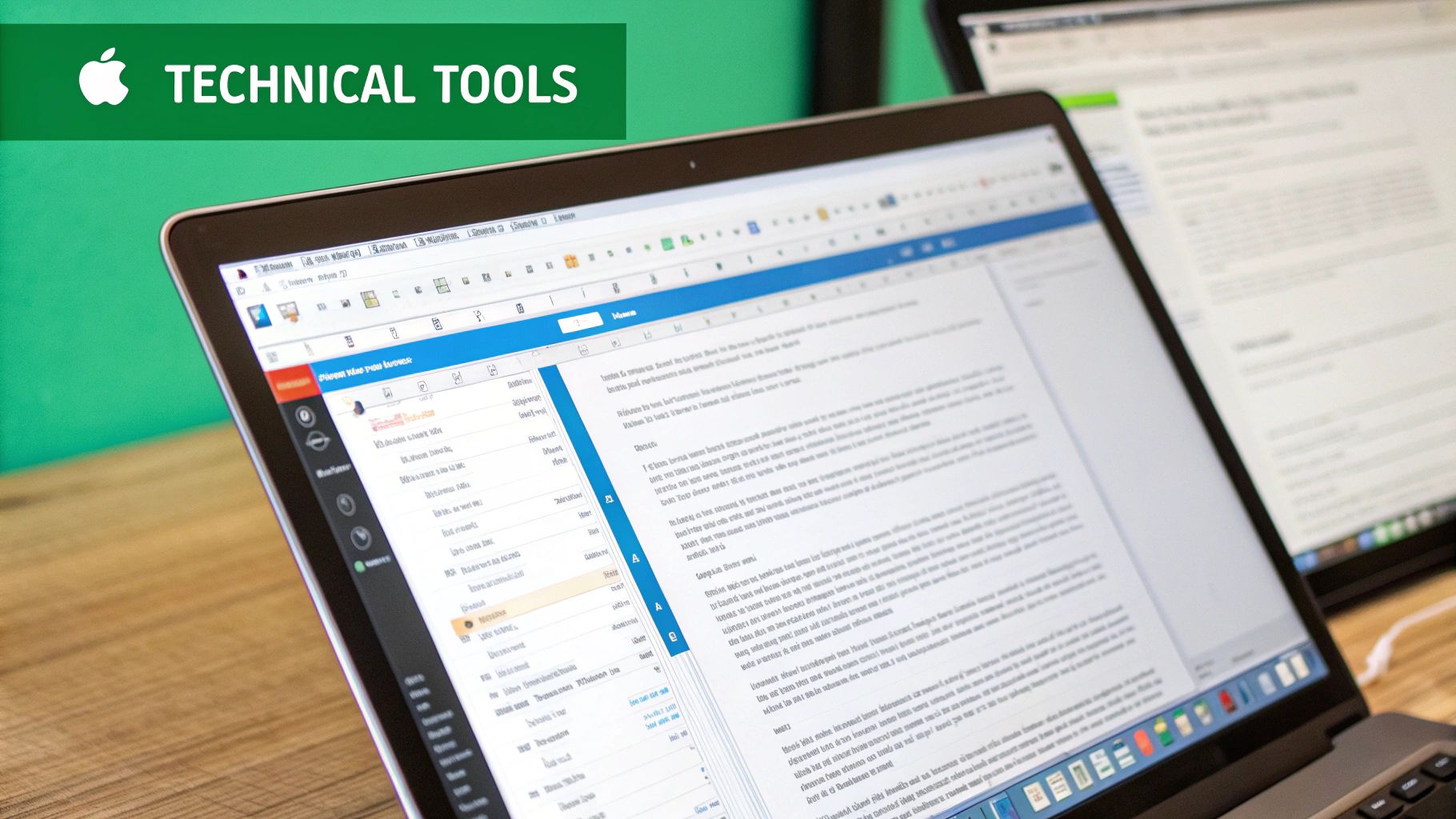Master professional documentation with leading technical writing softwares that drive results. Discover expert insights on choosing, implementing, and maximizing documentation tools for your organization.

In the early days, technical writers relied on basic tools like typewriters and paper documents. This made documentation work slow and prone to errors. The quality was inconsistent, updates were difficult, and distributing printed materials was expensive. The introduction of word processors changed everything - writers could now edit, format and duplicate their work with ease. While this improved efficiency, managing consistency across large documents remained challenging.
As word processors showed their limits with complex technical documentation, specialized writing software emerged. These new tools introduced single-sourcing - a central system for creating and reusing content across different outputs. For technical writers, features like version control became essential for tracking changes and working with teams.
Think about updating a 200-page user manual. With single-sourcing, changing one technical term automatically updates it everywhere in the document. This saves hours of work while keeping everything accurate and consistent. The creation of SGML (Standard Generalized Markup Language) in 1986 was another major step forward. It gave writers a structured way to separate content from formatting, enabling more advanced writing processes. Learn more about this journey here: Technical Writing History and Evolution
The internet brought major changes to technical writing. Online help systems became standard, giving users instant access to information. Writers had to learn new skills to create content for digital platforms. Collaborative writing platforms also emerged, letting multiple people work on documents at the same time. These tools added features like change tracking, commenting, and workflow management that made team writing much more productive.
Today’s technical writing software uses AI and automation in new ways. Tools like DocuWriter.ai can generate code and API documentation automatically, freeing writers to focus on strategy and user experience. Most platforms now work in the cloud, making it easy to access and collaborate from anywhere. Looking ahead, we’ll likely see new tools that make technical writing even more efficient while improving document quality and accessibility.

Getting your documentation into the hands of the right people at the right time is just as crucial as creating quality content. Modern tools offer multiple ways to share and publish documentation, making it easier to reach your intended audience effectively.
Different types of documentation need different delivery methods. Online help systems work great for software documentation since users can search for specific information while using the application. PDF documents still serve an important purpose for offline access and printed materials, especially for detailed technical guides.
Here are the main ways to distribute documentation:
Your audience’s technical background and learning preferences should guide your distribution choices. While developers may need detailed API documentation, end-users often prefer simple how-to guides. This means creating multiple versions of your documentation for different groups. Modern tools make it simple to adapt content for specific user needs.
Track key numbers to see what works and what needs improvement. Look at website visits for online help, PDF downloads, and user feedback on knowledge bases. This information helps refine your distribution approach. For instance, if certain help pages get little traffic, you might need better in-app links or search features. Many documentation tools include analytics to help gather and understand this data. Regular monitoring ensures your documentation effectively serves its audience.

Application Programming Interfaces (APIs) are fundamental building blocks of modern software development, enabling different systems to communicate with each other. Clear documentation is essential for developers to effectively implement these APIs in their projects. For technical writers, becoming proficient with specialized API documentation tools is a key part of creating helpful resources for developers.
Great API documentation needs to do more than just list technical specifications. It should provide developers with a complete understanding of implementation and usage. Here are the essential features that make this possible:
Finding the right documentation tool requires evaluating your specific requirements. Consider factors like your API’s complexity, team size, and technical expertise level. Tools like Swagger and Postman are popular choices that support markdown formatting and Git integration. Learn more about the field here: Technical Writing
When selecting a tool, evaluate practical aspects like cost, compatibility with your existing development stack, and ease of use. An intuitive interface can significantly boost your team’s productivity. The right documentation tool will help create clear, comprehensive API guides that make integration smoother for developers and improve the overall development process.

Picking the right technical writing software shouldn’t be complicated. Let’s focus on what really matters when choosing a documentation tool that will work best for your team’s needs.
The best technical writing software makes your work easier and helps teams work together smoothly. Here are the key features to look for:
Think beyond the initial price tag. Consider training costs, ongoing maintenance, and what it might cost to switch systems later - these make up the total cost of ownership. Sometimes the cheapest option upfront can end up being more expensive over time.
Recent data shows an interesting trend in technical writing. According to a 2023 JetBrains study, only 10% of people who write technical documentation are actual technical writers. The other 90% write documentation as part of their other duties. See the full report here: JetBrains State of Developer Ecosystem 2023
Start small when introducing new software. Test it with a smaller group first to work out any issues before rolling it out to everyone. Getting support from key decision-makers is crucial - show them concrete benefits and results from your test run to help them understand the value.
The right documentation software is the one that solves your specific problems. Focus on the features that will help your team the most. Take your time to evaluate options carefully, plan the implementation thoroughly, and keep communication clear throughout the process. This approach will help you choose a solution that truly improves how your team works.
A strong documentation team needs more than just good writers - it needs the right mix of people, tools, and practices working together. Here’s how to build and manage successful documentation teams that can scale effectively.
Good documentation requires clear communication between team members. This becomes even more important with remote teams spread across different locations and time zones. Tools like Confluence and GitBook help teams work together by enabling:
Managing documentation changes requires robust version control. Tools that integrate with Git repositories let teams:
Clear standards for style, terminology and formatting ensure professional documentation. Documentation platforms with built-in style guides and quality checks help by:
While automation helps with routine tasks, human expertise remains crucial. Writers bring:
As products and teams grow, documentation processes need to scale too. Important elements include:
Documentation software continues to advance with better technology and methods. For technical writers to create excellent documentation, they need to understand and work with these new developments. The latest documentation tools incorporate AI capabilities, automation features, and modern content delivery systems that make the work more efficient.
AI is changing how we create and manage technical documentation. Tools like DocuWriter.ai now handle tasks like generating API docs and parsing code automatically. This frees up writers to focus on important work like planning, user experience design, and fact-checking. AI assistants can create first drafts, improve text clarity, and produce documentation in multiple languages - making the process both faster and more accurate. Want to learn more? Check out How to master software technical documentation.
Users now expect different types of documentation. They want: